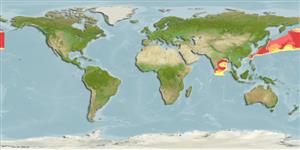Elasmobranchii (tubarões e raias) (sharks and rays) >
Squaliformes (Sleeper and dogfish sharks) >
Somniosidae (Sleeper sharks)
Etymology: Scymnodon: scymnus, an ancient name for some kind of shark, derived from a Greek word meaning young animal, cub or whelp; odon (Gr.), tooth, referring to large, triangular cutting teeth on lower jaw of S. ringens. (See ETYFish); ichiharai: In honor of marine biologist (specializing in whales) Tadayoshi Ichihara (d. 1981), Tokai University (Tokyo, Japan), who suggested that the authors study this shark. (See ETYFish).
More on authors: Yano & Tanaka.
Environment: milieu / climate zone / depth range / distribution range
Ecologia
marinhas batipelágico; intervalo de profundidade 500 - 800 m (Ref. 31249). Deep-water
Indo-West Pacific: Japan (Ref. 31249) and India (Ref. 118627).
Tamanho / Peso / Idade
Maturity: Lm ? range ? - ? cm
Ovoviviparous (Ref. 205).
Life cycle and mating behavior
Maturidade | Reprodução | Desova | Ovos | Fecundidade | Larvas
Distinct pairing with embrace (Ref. 205).
Yano, K and S. Tanaka, 1984. Review of the deep sea squaloid shark genus Scymnodon of Japan, with a description of a new species. Jap. J. Ichthyol. 30(4):341-360. (Ref. 31249)
Categoria na Lista Vermelha da IUCN (Ref. 130435)
Ameaça para o homem
Harmless
Utilização humana
Mais informação
Idade/Tamanho
Crescimento
Comprimento-peso
Comprimento-comprimento
Frequência de comprimento
Morfometria
Morfologia
Larvas
Dinâmica larvar
Recrutamento
Abundância
BRUVS
ReferênciasAquaculturaPerfil para aquaculturaEstirpesGenéticaElectrophoresesHereditariedadeDoençasProcessamentoNutrientsMass conversion
ColaboradoresFotografiasStamps, Coins Misc.SonsCiguateraVelocidadeTipo de nataçãoÁrea branquialOutras referênciasCérebrosVisão
Ferramentas
Relatórios especiais
Descarregue XML
Fontes da internet
Estimates based on models
Phylogenetic diversity index (Ref.
82804): PD
50 = 0.7500 [Uniqueness, from 0.5 = low to 2.0 = high].
Bayesian length-weight: a=0.00389 (0.00168 - 0.00901), b=3.13 (2.94 - 3.32), in cm total length, based on LWR estimates for this (Sub)family-body shape (Ref.
93245).
Nível Trófico (Ref.
69278): 4.2 ±0.7 se; based on size and trophs of closest relatives
Resiliência (Ref.
120179): Baixo, tempo mínimo de duplicação da população 4,5 - 14 anos (Fec assumed to be <100).
Fishing Vulnerability (Ref.
59153): Very high vulnerability (84 of 100).
